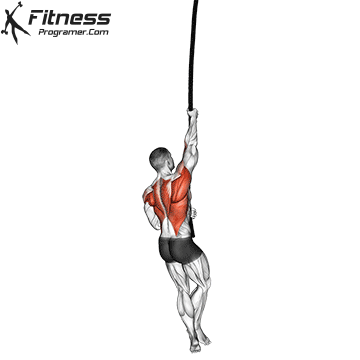Legless Rope Climb
A rope climb is a physical activity or exercise that involves climbing a rope suspended vertically. It is often used as a training exercise in various fitness programs, sports, and military training for building upper body strength, grip strength, and overall physical coordination. Rope climbs can be done in different ways, but the most common technique involves using your hands and feet to ascend the rope. This exercise can be quite challenging and requires a combination of strength, technique, and endurance.
how to do:
Climbing a rope without using your legs, known as a “legless rope climb,” is an advanced skill that requires exceptional upper body strength and technique. Here’s a step-by-step guide on how to perform a legless rope climb:

- Grip: Begin by standing facing the rope. Reach up with both hands and grip the rope firmly. Your hands should be about shoulder-width apart, and your palms should face each other.
- Hollow Body Position: As you lift your legs off the ground, engage your core muscles to create a “hollow body” position.
- Initial Pull: Begin the climb by pulling yourself up using your arms and core strength. It’s important to engage your back, shoulders, and arms to initiate the pull.
- Hand-Over-Hand: Use a hand-over-hand motion to grip the rope alternately. Pull down with one hand while reaching up with the other hand. This motion helps you ascend the rope. Remember, your legs are not involved in the movement.
- Core and Upper Body Strength: Your core muscles are crucial in maintaining stability, and your upper body strength will drive the climb. Focus on controlled movements and maintain tension throughout your body.
- Climb Continuously: Continue the hand-over-hand motion while maintaining the hollow body position. Use your arms to generate the pulling power and maintain your grip on the rope.
- Top Position: Keep climbing until you reach the top of the rope or your desired height. At the top, you can use your arms to grip the rope and stabilize yourself if needed.
Descending: To descend, slowly release your grip one hand at a time, maintaining control as you lower yourself down the rope. You can use your legs to assist in the descent if necessary.
Tips:
- Legless rope climbing requires exceptional upper body strength, core engagement, and grip strength. Ensure you are well-prepared before attempting it.
- Warm up your upper body and grip muscles thoroughly.
- Use gloves to protect your hands from rope burn.
- Focus on maintaining proper technique and keeping your body in a hollow position.
Legless Rope Climb Benefits
Upper Body Strength: Legless rope climbing heavily targets the muscles of your upper body, including the back, shoulders, arms, and chest. The pulling action required to ascend the rope helps develop strength in these muscle groups, promoting muscle growth and functional strength.
Grip Strength: Holding onto the rope without the assistance of your legs requires a strong grip. This exercise can significantly improve your grip strength, which is valuable in various athletic activities and functional movements.
Core Engagement: To maintain proper form and stability during a legless rope climb, your core muscles are continuously engaged. This exercise can help strengthen your core muscles, contributing to better posture and overall stability.
Body Control and Coordination: Legless rope climbing demands precise body control and coordination to maintain balance and perform the hand-over-hand movement effectively. This can improve your overall body awareness and coordination.
Functional Fitness: Legless rope climbing is a functional exercise that mimics real-world movements, such as climbing obstacles or scaling heights. This can improve your ability to handle various physical challenges and everyday activities.
Cardiovascular Endurance: Rope climbing, especially in the legless variation, requires a combination of strength and endurance. The intense effort involved in pulling yourself up the rope can elevate your heart rate and contribute to cardiovascular conditioning.
Athletic Performance: The strength and skills gained from legless rope climbing can translate into improved performance in other sports and physical activities that require upper body strength, grip, and coordination.
Legless Rope Climb Muscles Worked
- Upper Back Muscles: The muscles of your upper back, including the latissimus dorsi and trapezius, are crucial for initiating the pulling motion. As you pull your body up the rope, these muscles contract to create the driving force.
- Shoulder Muscles: The deltoid muscles play a significant role in controlling and stabilizing your arm movement during the climb. They assist in lifting your body and contribute to the fluidity of the hand-over-hand motion.
- Biceps and Forearms: Your biceps brachii and forearm muscles, including the brachioradialis and wrist flexors, work synergistically to grip the rope tightly and generate pulling power. These muscles endure constant tension as you ascend.
- Core Muscles: Maintaining a stable hollow body position is key to legless rope climbing. Your rectus abdominis, obliques, and transverse abdominis engage to provide core stability and prevent excessive swinging or twisting.
- Chest Muscles: The pectoralis major, particularly the upper portion, assists in the pulling action as you lift your body upward. These muscles contribute to the overall strength of your upper body.
- Scapular Stabilizers: Muscles that stabilize the scapula, such as the rhomboids and serratus anterior, play a vital role in keeping your shoulder blades secure against your ribcage during the climb. This stability enhances your control and efficiency.
- Grip and Forearm Flexors: The muscles responsible for gripping, including the flexor digitorum profundus and flexor digitorum superficialis, contract continuously to maintain your grip on the rope.
- Lower Back Muscles: While not the primary movers, the muscles of the lower back, such as the erector spinae, help in maintaining a straight posture and preventing excessive arching.
- Hip Flexors and Glutes: These muscles play a minor role in stabilizing your lower body as you maintain the hollow body position throughout the climb.

